Text
Ostara Crash Course
This year, Ostara is on March 20th. Happy Ostara folks!
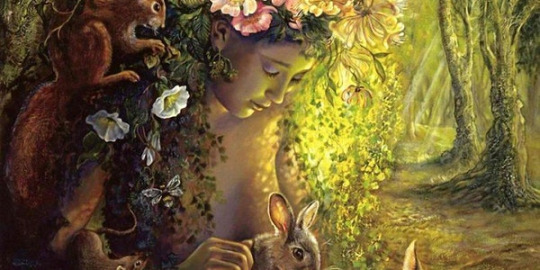
What is it based on?
Ostara celebrates the spring equinox.
It falls between March 19th and 21st each year.
In ancient times, it was celebrated through a festival.
The festival celebrated Esotre, a Germanic goddess of fertility, spring, and the dawn. According to Bede, Eostre was the Saxon version of Ostara. There are also speculation that Eostre formed from the Greek goddess Eos.
Festivals were put on to represent the rising of spring energy.
It was not necessarily seen as a holiday so much as an opportunity to celebrate
It is believed Ostara and Eostre led into modern celebrations of Easter.
Eostre was associated with hares and eggs, which is how these symbols became tied into the holiday.

How to celebrate?
Ostara is the time to cleanse with the intent of bringing in new life and energy into your life. Spring renewal is the celebration of a new dawn.
Cook egg-based dishes. Egg custards, deviled eggs, frittatas.
Bake hot-crossed buns or a rhubarb pie.
Go for a nature walk and photograph, journal, and seek out signs of spring.
Decorate coloured eggs (good colours to choose are lavender, red, yellow, or green).
Brew and drink dandelion tea. And even better, throw a spring tea party to enjoy it!
Plant seeds and tend to your garden, nurturing new life.
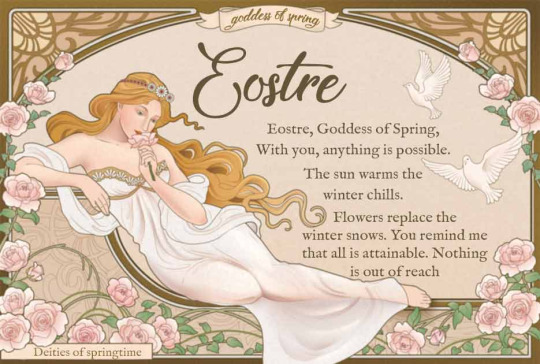
Who is Eostre?
Eostre is an interesting deity from an academic perspective.
The story told is that Eostre found a injured bird in winter and to save it, she transformed the bird into a hare. The hare retained its ability to lay eggs and thus, laid the eggs and decorated them as a gift to Eostre.
There is very little writings from ancient times that actually depict her, and from what my research showed me, the main documented source of her existence is from Bede. Bede was a Christian monk.
Some sources I've seen have traced the story of Eostre creating an egg-laying hare to a German writer in the 1890s. It is uncertain if the goddess herself is also as recent of a figure, or if she was celebrated and worshipped in ancient times.
Eostre was a symbol of new dawn and fertility.

Symbols
Hares are one of the main symbols of Ostara. There are a few reasons, one of them being the listed story above. However, they are also known to mate during spring and mate with fervor, a signal of the change of season. They are a sacred animal to Eostre.
Other animals that are celebrated during the festival are birds (because of the aforementioned story), lambs, and chicks.
Eggs are a powerful sign of fertility and new life, and so focus heavily in celebrations of Ostara.
Spring flowers like daffodils, clover, and tulips.
Honey.
Rhubarb.
Colours like green, lavender, yellow, and red.
Sources:
https://blogs.loc.gov/folklife/2016/04/ostara-and-the-hare/
https://www.mabonhouse.co/ostara
https://www.learnreligions.com/history-of-ostara-the-spring-equinox-2562485
https://www.pagangrimoire.com/ostara-celebrate/
https://en.wikipedia.org/wiki/%C4%92ostre
https://www.northernpaganism.org/shrines/ostara/about.html
This was one of the most interesting holidays I've gotten to research so far! I had no idea that Eostre's story (and potentially her existence as a whole) was a more modern creation, or that Ostara as a festival evolved into Easter. As per usual, this is a simplified version of the history and the goddess involved, I highly encourage you to read the sources above and do your own research.
#paganlife#pagan witch#witchcraft#witch content#magic#magick#pagan#season#spring#ostara#spring equinox#wheel of the year#witchythings#green witchcraft#green witch#march 2022#holiday
3 notes
·
View notes
Text
Lupercalia Crash Course
Date of Lupercalia: February 15th

What is Lupercalia?
This is a Roman holiday that can be traced back as far as 6th century BCE. Some even believe it could have been celebrated right from the first emergence of Rome, and was celebrated for upwards of 1200 years. It was a festival that was, at points, celebrated from the 13th to the 15th and at others, just on the 15th. It is speculated that Lupercalia and Valentine's Day were celebrated as a singular festival and later became two different holidays.
The idea behind Lupercalia was to celebrate the she-wolf (lupa) who suckled Remus and Romulus when they were babies. It is named after the Lupercal, the cave the she-wolf used as a den until the shepherd found Remus and Romulus.
How was Lupercalia celebrated?
The festival started at the Lupercal.
A group of Roman priests would sacrifice a goat (to represent sexuality) and a dog. This was unusual in the realm of sacrifices as in most rituals, a pig, sheep, or bull was far more common.
Two naked priests, intended to stand in for Remus and Romulus, would have the blood-covered knives smeared across their foreheads and then removed with milk-soaked wool. Interestingly, laughter was an obligation during this part of the ritual.
This would be followed by a massive feast.
Once the feasting was done, whips called februum would be made out of the hides and the Luperci would run naked, or near naked, through the Palantine and smack women with them. It was not done with any aim to hurt, though. It was generally lightly done. Women turned up in droves in hopes of being whipped as it was believed to bring fertility and better birthing processes to any woman hit with it (actively getting in the Luperci's way to be hit was considered poor sportsmanship, so their best bet was to stand as much in the way as possible and hope for the best). This was also believed to purify the land.
Over time, the nakedness was tapered down as was the way the whipping was performed. Any part of a woman had been fair game, previously, but as time went on it was largely done on the palm.
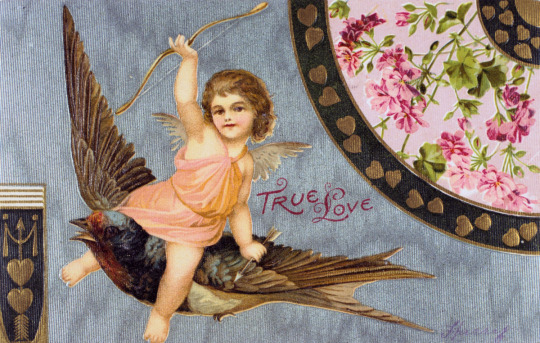
How to celebrate Lupercalia now?
Anything that focuses on sexuality, purification, and fertility are fair game!
Now is a great time to offer sacrifices to your gods.
Especially those of the Roman variety or fertility and love deities.
Meat, chocolate, honey, or wine are great fits for offerings today.
Tend to the fertility of your land.
Garden!
Cleanse and give your house plants a bit of extra care and love.
Purify yourself or your home.
Go take a cleansing bath or shower.
Tidy up your room, bathroom, or office, places of fertility and abundance and love.
Refresh your altars.
Put together a fertility lotion, jar, or meal.
Cook with meats, wine, and honey.
Cook with cinnamon, garlic, cayenne, ginger, and tumeric.
Bless a bottle of lotion to bring you confidence and fertility.
In general... a lot of ancient Lupercalia traditions would probably get you arrested. Here are just a few fun ideas to spice up your day and have some fun!

For a lot of pagans, Lupercalia is a great alternative holiday to celebrate over Valentines day. Take the day and go get some discounted chocolate for yourself or with your partner(s). Have some fun, feel sexy, do sexy things, and encourage self love and abundance and fertility! It's a great day to have fun and feel the love.
Sources:
https://www.thoughtco.com/the-roman-festival-of-lupercalia-121029
https://www.theguardian.com/science/2018/feb/15/wolves-nudity-mayhem-why-an-ancient-roman-festival-is-still-controversial
http://www.imperium-romana.org/lupercalia.html
https://www.mentalfloss.com/article/572191/lupercalia-ancient-roman-festival-facts
https://www.history.com/topics/ancient-rome/lupercalia#:~:text=Lupercalia%20was%20an%20ancient%20pagan,in%20Rome%20on%20February%2015.&text=Unlike%20Valentine's%20Day%2C%20however%2C%20Lupercalia,off%20evil%20spirits%20and%20infertility.
https://indigospirituality.com/modern-lupercalia-ritual/
https://eclecticwitchcraft.com/lupercalia-traditions-for-the-modern-witch/
https://wellseek.co/2018/04/26/6-kitchen-herbs-spices-boost-fertility/
#lupercali#february#witchcraft#paganlife#witch content#magick#season#spring#magic#pagan#witches of tumblr#witchy#witchblr#pagan witch#witchyvibes#festiveseason#festivevibes#tradition#romantic#romance#roman#history
9 notes
·
View notes
Text
How to Celebrate Imbolc (more indepth)
So, I put out my crash course post when it comes to Imbolc but with the day fast approaching, I wanted to go more in-depth with ideas on how you can easily celebrate Imbolc this year!
Most of what's listed here will seem pretty boring and mundane, but I think it's important to remember that the little joys are just as magical as anything else. If it brings you happiness and contentment then that's plenty celebration enough! Magic should nourish the soul not feel like a chore, so pick what most calls to you and take this as a fun opportunity to do it.
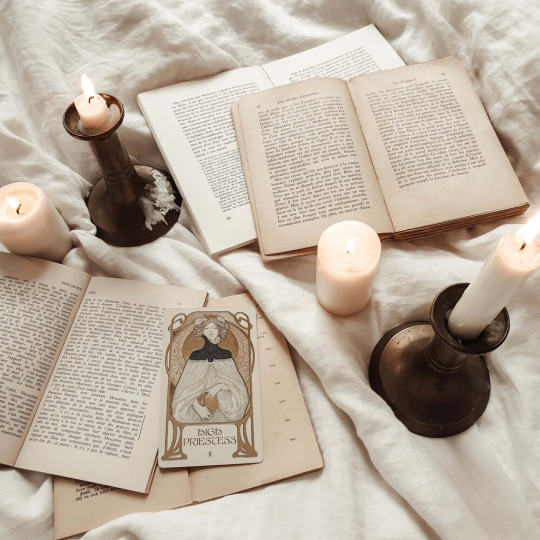
What are we celebrating?
Spring! And as such, in general, anything that you can think to do that celebrates spring will work pretty well. With spring comes new life. Warmth, joy, renewal. The end of winter. Purification, new starts. Anything in your life that brings about those feelings in you is what matters. But, I also understand that sometimes, that's very broad and a hard place to start, so here's some more ideas!
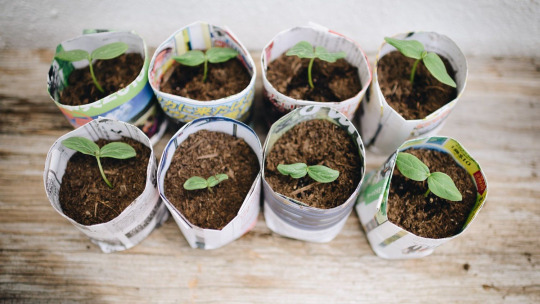
Get to planting!
- Go to a local nursery and see what's currently in season for planting. Are there any seeds you can grow that will thrive in the environment you can provide them with?
- Start to plan out a future garden! Take some time to think about what might suit you and what type of agricultural goals you have to achieve. Do you want a plant garden? A flower garden? Both? This is a great time to give that some thought.
- Learn more about your local fauna and what you can do to support it. Are there local ecosystems that are in need of cleaning to best grow as the season turns over. Set your local area up for success! Whether that's a nearby forest, your neighborhood street, or a park by your house!
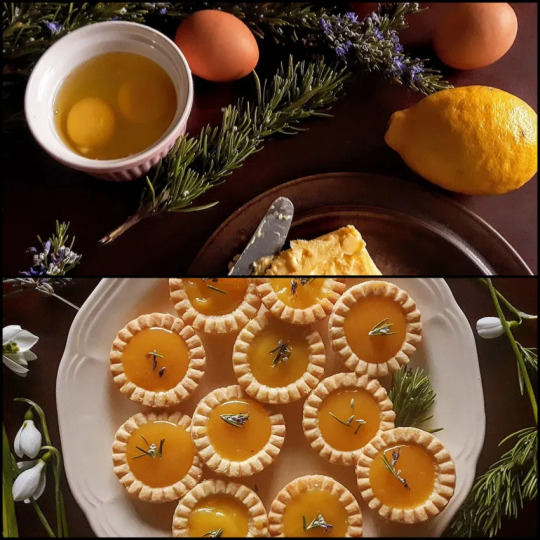
Get to cooking!
Imbolc celebrates the hearth and home as much as anything. Breads and cakes were key to the feasting and celebrating of Imbolc, and still are to this day. We want to celebrate the fruits of earth and Brighid.
So, here are some things you can cook to ring in the
season:
- Oatcakes
These were left out on Imbolc's eve (that's today!) as an offering to Brighid. Throw a piece over your shoulder in your garden/a local field to honour Brigid and nourish the land!
https://www.reclaimingpgh.org/a-recipe-for-imbolc-oatcake-for-brighid/
https://thetravelbite.com/recipes/nova-scotia-oatcakes/ (these are the ones I plan to make myself!)
- Pancakes
Round and warm like the sun! You can get to cooking these to celebrate the harvest. Imbue a wish into your pancake batter, make a wish when you flip it, and leave the last pancake in your cupboards to ensure there's plenty of flour for the winter!
https://www.allrecipes.com/recipe/21014/good-old-fashioned-pancakes/
- Blackberry Muffins
Blackberries were sacred to Brighid and used as a tool in prosperity and purification magic.
https://www.simplyrecipes.com/recipes/blackberry_muffins/
https://www.beyondthechickencoop.com/blackberry-muffins/
- And in general, foods that feature cheese and milk
Ewe's milk plays a large role in the celebration of Imbolc. Foods that place them as a central ingredient will work well!

Get to cleaning!
Tis the time to spring clean. Purify your home and life with a bit of tidying up. Rejuvenate your altars, organize your bedroom, get to that cleaning task that has been wriggling in the back of your mind for the last few weeks but you haven't been able to muster up the motivation for it.
The home is deeply important in the celebration of Imbolc; warmth and domesticity play big roles in the historic celebration.
And if you want to feel a bit fancy, give your home a quick cleansing. Remember to be mindful of open and closed practices as you do this! Incense is just as effective in purifying as sage.
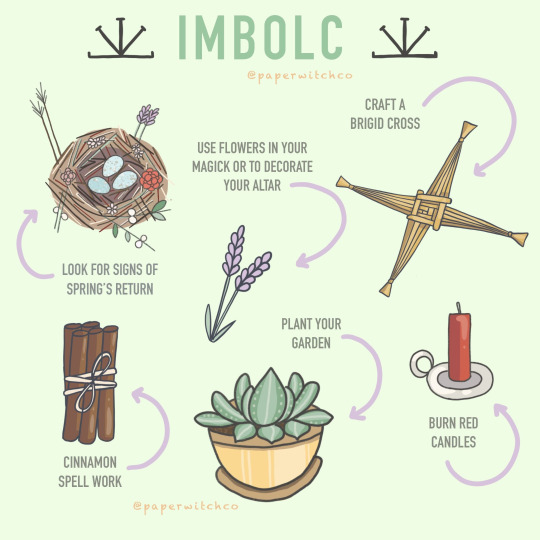
Get to crafting!
- Brighid crosses
Generally these were created with rushes. But for those of us without easy access, pipe cleaners will do!
- Brighid doll
These were left out in baskets on the night of Imbolc, traditionally. This is a straw doll believed to attract fertility and abundance to the home.
https://www.youtube.com/watch?v=_axrwXKBMuA&ab_channel=WrightAtHome
And of course, some rituals!
As there are so many different options on this front, I'll give some general ideas that should be central if you wish to form your own ritual and then include some specific ideas in links!
- Candle rituals
The Catholicized celebrations of Imbolc is also known as Candlemas. And even in the pre-Christian celebrations of Imbolc, candles were used to guide Brigid to the homes of those honouring her.
- Devotions and prayers
Honour the goddess Brighid, the end of winter, abundance of food, the warmth of the hearth, and the joy in your home.
Meditation and home cleansing rituals (as mentioned above) are also very well timed on Imbolc.
https://www.learnreligions.com/imbolc-rituals-and-ceremonies-4157556#:~:text=Imbolc%20is%20the%20season%20of,the%20cup%20to%20the%20sky.
https://www.theseasonalsoul.com/imbolc-rituals/
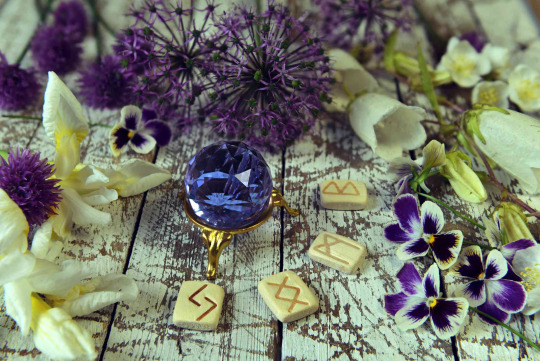
In general, take this as an opportunity to care for yourself and your home. Take some time to breathe, enjoy the change of the season, and consider what you can to do better thrive.
All of the information gathered above was found in the sources listed below! Give them a gander if you want more information and use them as a great jumping off point to do your own researching and looking around.
Happy Imbolc!
https://thegreenparent.co.uk/articles/read/six-ways-to-celebrate-imbolc
https://www.learnreligions.com/guide-to-celebrating-imbolc-2562102
https://www.thesimplethings.com/blog/imbolc
https://gathervictoria.com/2016/01/20/midwinter-feast-of-light-reviving-the-magical-foods-of-imbolc/
https://en.wikipedia.org/wiki/Brigid%27s_cross
https://colorful-crafts.com/how-to-make-a-brigid-doll-straw-doll/
#february#imbolc#witchcraft#magick#season#spring#magic#paganlife#pagan#witch content#beginner witch#green witch#witchyvibes#witchythings#witch aesthetic#witchcore#witches of tumblr#witches
4 notes
·
View notes
Text
Spring Festival Round-Up
Imbolc
This is a holiday celebrated on February 2nd to mark the start of spring. Largely, this was a Gaelic holiday, and takes it's name from the Irish Gaelic word Oimelc, which translates to "ewe's milk".

Candlemas
This is the Catholic version of Imbolc. It celebrates St. Brigid, the Catholicized Irish goddess Brigid. Candlemas was celebrated to stave off the dark of winter and bring in the light of spring. Candles were carried to the church to be blessed by the priest on this day. The celebration of this holiday went beyond Ireland. In Armenia, fires would be built and people would hop over them and dance around them as a way to celebrate and signify purification. These fires were often placed in church courtyards and embers would be carried home for their own fires. As well, farmers used this day as a marker for the length of winter. If the light of the sun was brighter than the light of the candles, then it was considered that winter would last longer. If the light of the candles was brighter than the gloom of winter, then it was believed winter would end soon. This later became Groundhog's Day.
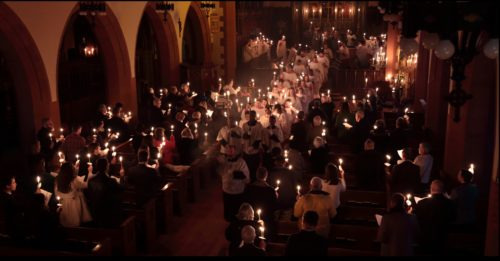
Lupercalia
This Roman holiday was celebrated on February 15th under the guidance of a corporation of priests called Luperci. There is no one specific deity or temple that is associated with this holiday. Instead, it celebrates the she-wolf Lupercale who nursed Remulus and Romulus. It was a large purification ritual that was started off with the sacrificing of a goat and a dog. After the ritual ended, there would be a massive feast. And finally, thongs would be created from the animal hides and the priests would form two bands to run around the city and strike at women with them. Women who were hit were considered lucky and fertile.
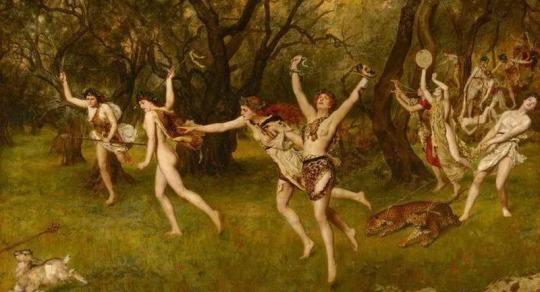
These are not the only spring-time festivals being celebrated, but they were three that I could find enough information on to comfortably put together a post on them! I also found mention of he Feast of Nut, but as I could not find enough information on it and it is not something a part of my own personal culture, I opted to not include it in this post.
https://www.learnreligions.com/history-of-the-pagan-holiday-imbolc-2562118
https://www.watkinspublishing.com/imbolc-or-candlemas/
https://catholicstraightanswers.com/candlemas-day/
https://www.timeanddate.com/holidays/canada/groundhog-day
https://www.britannica.com/topic/Lupercalia
#lupercalia#imbolc#wheel of the year#paganlife#pagan#witch content#witchcraft#ceremony#festival#tradition#spring
34 notes
·
View notes
Text
Imbolc Crash Course
This year, Imbolc is on February 2nd.
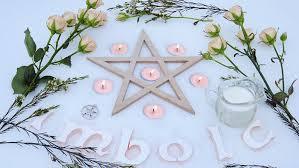
What is it based on?
Also known as Candlemas.
It celebrates the coming of spring.
Generally, the date is placed halfway between Yule and Ostara.
It began in the pre-Christian era on the British isles.
First mentions of it come from Irish literature, with mentions in poetry that relate it to ewe’s milk and purification.
Speculation that it may have been celebrated in line with the breeding cycle of sheep. So, when lactation started, they celebrated Imbolc.
Celebration were based around Brigid, who was evoked in fertility rituals and oversaw poetry, crafts, and prophecy.
Traditions included:
Creating an oat and rush effigy of Brigid that they would put in a dress and place in a basket overnight on February first.
Burning lamps and bonfires to celebrate Brigid on the day of.
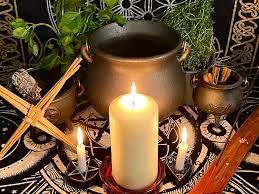
How to Celebrate
Some easy examples include:
Set up an Imbolc altar.
Perform a candle ritual.
Prayers and devotions related to the shift from winter to spring.
Cleansings:
Of yourself, with a bath.
Of your home by cleaning and organizing.
Creating a cross of Brigid or a Bridey doll.
Plant seeds.
Cook and eat foods that celebrate the hearth and home.
- Breads and grains.
- Vegetables.
- Dairy.
In general, celebrate rebirth. Celebrate the new season and the new life that comes along with it. Do what brings forth passion and fire and warmth. Find joy and comfort in domesticity.

Who is Brigid?
The daughter of Dagda.
Goddess of fertility, healing, fire, sun, and poetry.
She is triple-aspected and Imbolc celebrates her Maiden aspect.
Her other two aspects, also named Brigid, were of healing and of the smithy.
She rules the fire of the hearth and the fire of imagination, channelled through poetry.
The fire of the blacksmiths.
Candles, bonfires.
A perpetual flame to Brigid has burned for centuries, minded by priestesses, in the town center of Kildare.
Later became Saint Bridget.

Symbols of Brigid
The snowdrop.
The swan.
The flame.
The serpent.
Sheep.
Silver (purity), green (fresh life), and red (fire).
Symbols of Imbolc
Blackberry.
Coltsfoot.
Ginger.
Rowan.
Willow.
Sources
https://www.goddessandgreenman.co.uk/imbolc-candlemas/
https://mythopedia.com/topics/brigid
https://www.britannica.com/topic/Brigit
https://www.history.com/topics/holidays/imbolc
https://www.learnreligions.com/guide-to-celebrating-imbolc-2562102
This post is a compilation of the above sources. It is a simplified version of the information regarding this complex and history-rich holiday and deity! If any of this interests you, I encourage you to do your own research and discover for yourself. Truly, it is in the spirit of the season!
41 notes
·
View notes
Text
The Early Influences of Tarot
Many theories on the start of tarot cards exists. Some credit them to the Romani people. Some say that they were brought to us by the Crusaders after their time in the Middle East. Others, even, think they may have dated back further into Ancient Egypt, a full 2,000 years in the past.
However, from Arabia, Spain, and Italy, we see three distinct presentations of cards as important sources of influence towards modern tarot as we know it.
The earliest influence came from within Islam. This was the Mamluk pack in the 14th and 15th century. Similar to Minor Arcana, the deck of cards had four suits (coins, cups, swords, and polo sticks) and ten numbered cards and three court cards per suit. The difference in the court cards is that rather than queen, king, knight, and page, we see the king (malik), the lieutenant (nā'ib malik), and the second lieutenant (thānī nā'ib).
In present day an original deck resides in the Istanbul Topkapi Museum. Widely, it is assumed that these cards were used for fortune telling as well as gaming.
In Italy, starting in the 15th century wealthy artists began to commission cards known as trionfi to play the game Il Trionfos. They were hand-painted or printed with carved woodblocks and the themes on the cards were used to inspire players to write poetry about each other. The earliest deck was commissioned by the Duke of Milan in the mid 1400s, known as the Visconti Tarot. It now can be found in New York’s Morgan Library & Museum.
And lastly we move to Spain. The decks in question contained 49 colourful cards often used to tell fortunes and reveal secrets, particularly those related to love. They were also used to play the game Juego de Naipes.
The decks had four suits of the maidens, the wives, the widows, and the nuns, as well as verses written on the cards, containing the same amount of lines as the card’s number.
The cards first appeared in the 15th century, but it wasn’t until the 17th century that professional “cartomancers” began to tell fortunes in Spain using tarot spreads similar to what is used in the present day.
Notable is that many of these decks were more challenging to read and had far more individualistic interpretations as they did not always contain story-telling imagery in the way that modern tarot decks are. It was closer to the twentieth century that tarot began to more resemble what we are familiar with today.
Sources:
Modern Witchcraft Book of Tarot by Skye Alexander
https://www.wopc.co.uk/egypt/mamluk
https://beinecke.library.yale.edu/collections/highlights/visconti-tarot
0 notes
Text
A Brief Introduction
i am a freshly graduated English and History major with a lot more time on my hands and the startling realization that i can now research my own fun little passions. and very recently, i have felt a strong pull towards witchcraft and a desire to understand tarot, which i’ve been practicing for a little while now. and with more time on my hands, well... i want to start taking a deeper dive into these things. where better to put that than here?
i have a handful of weeks left with access to my university’s library and the goal is to grab as many peer-reviewed papers on tarot, witchcraft, the fae, mythology, gods and goddesses, whatever passes my fancy. occult stuff!
there seems to be a lot of awesome information floating around the witch community around here and i think that some people might find an approach that is source based to be a useful addition! if not, then i get to chronicle my own research for future reference purposes. a win win, in my books.
#witch#witchcraft#witch content#occulltism#magick#academic research#academia#tarot witch#tarotblr#witchblr
2 notes
·
View notes